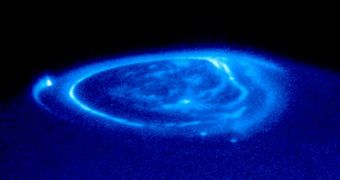The newly discovered glowing feature in Jupiter's atmosphere seems to be produced by a stream of electrically charged particles rushing from the planet's small volcanic moon Io, much in the same way the solar wind determines the appearance of aurora borealis on Earth in the polar region of the planet. According to planetary scientists, Io, one of the most volcanic body in the solar system, having the surface almost entirely covered by molten lava, regularly intersects the powerful magnetic field of Jupiter.
Electrically-charged sub-atomic particles Io ejects are gathered by the magnetic field and transported towards the planet. It is approximated that about one ton of material is stripped away from Io each second, carried to Jupiter's atmosphere where it forms a doughnut-shaped cloud. While orbiting the planet, plasma rushes around Io to create a high speed flow of electrons, which collides with Jupiter's atmosphere and ionizes it to determine aurora-like glowing features.
Against general belief, which states that aurora-like features occur in the upstream of the electron flow, on Jupiter the giant glowing spots appear in the downstream of the flow from the plasma torus. University of Liege researcher Bertrand Bonfond says that "the results are surprising because no theory predicted upstream spots."
The study conducted by Bonfond and his colleagues are based on observations with the Hubble Space Telescope in the ultraviolet wavelengths of the electromagnetic spectrum. The most likely explanation for the upstream aurora would be that interactions between Io and Jupiter actually determine the electron flow to take a curved trajectory so that, instead of hitting one hemisphere, it would go around the moon and hit the opposite hemisphere, thus creating unexpected features in Jupiter's atmosphere.
Although the findings are relatively new, the phenomenon might be more common in the universe than previously believed, especially with electrically conductive bodies such as Io orbiting massive objects. The phenomenon could be just as well occurring in other solar systems, between exoplanets and the stars they orbit. Bonfond hopes that the theory can be tested through new observations on Jupiter as soon as the scheduled maintenance mission to Hubble is completed.

 14 DAY TRIAL //
14 DAY TRIAL //